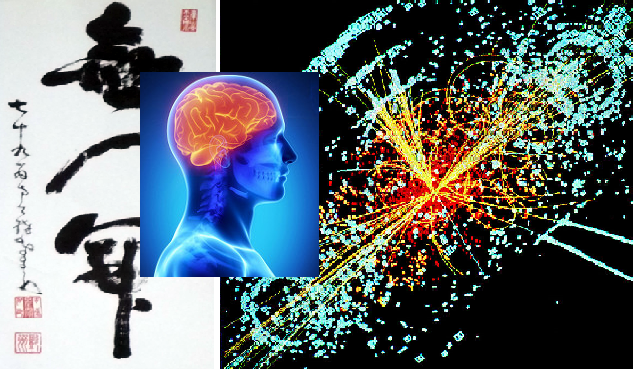My favorite theory, from my favorite mind, elaborate now to include “retro-activity!”Orch-OR is the Penrose/Hammeroff theory that Shrödinger’s cat dies or survives, not both in two different universes, nor both at once in this universe until a conscious observer looks inside the box, but as an objective, natural consequence of a feature he purposes for gravitational fields: they are sensitive to phase variation in ways that quantum fuels aren’t, so the superpostition that is so comfortable for subatomic particles becomes intolerable in a gravitational field. He suggests that the wave function of a particle with mass that is in a superpostition of being in two places at once, spontaneously collapses once the separation gets to about the Plank length (1.6 x 10-35 meters.) This is his theory of Objective Reduction (OR.)
Things get REALLY cool when you take the next step. Sir Rodger Penrose is famous for many things, sharing the Novel prize with Steven Hawking for their work on black holes is one, Penrose tiles are another. Penrose tiles are collections of a few shapes that, like Escher’s lizard, can “tile the plane,” meaning you can connect them up together so they cover every bit of a flat surface with no gaps, out to infinity in all directions. The difference from Escher’s is that, although you cannot prove with a computation that it works with them, no matter how powerful your computer is, still a normal person can look at them and fairly quickly comprehend that it does. This leads him to believe that there is something about comprehension that is non-computational.
Could it be that OR is the LEGO brick of consciousness, like particles are the LEGO bricks of, well, Legos? His theory is that the natural collapse of quantum weirdness into classical reality is a little flash of proto-consciousness, which our experience is then built up from.
Enter Steve Hammeroff, the anaesthesiologist who, upon learning about OR, suggests that superpositions of electron states in the pi bonding orbitals of organic molecules in the microtubule scaffolding inside neurons organize on a large scale, and that this organization, or rather the repeated formation and collapse of these massive superpositions ARE conciousness itself. This gives comprehension a very real, physical, but non-computational foundation. Thinking, then, is the process of orchestrating this process by building microtubule structures that support various interactions with each other and the environment. Orch-OR.
I’ve been following Orch-OR for a decade or so, hoping that something would happen while Sir Rodger is still alive and thinking (he’s 92 now, and still very much both.) In these interviews he introduced a very cool, new twist which involves a curious truth about the current state of scientific knowledge about the world. Consciousness is the ONLY phenomenon in science that requires time to flow, let alone to always flow forward. The new twist is that the very rigorous math behind OR can bridge the gap perfectly between relativity and quantum mechanics IF the collapse of the wave function travels back in time along it’s own light cone (the set of all events going back in time that could have a casual effect, honoring the speed of light) to alter all the quantum events still in superpostition so that afterwards, it’s like there was only ever one outcome, and superpositions were just superstitions, I e., the works we live in, ruled by classical physics. As the collapse propagates, it erases the “many worlds” that might have been, and solves Einstein’s “spooky action at a distance” problem with entanglement (without abandoning either locality or causality.) The effects go backwards in time, then unspool again such that my measurement of, say, the spin up or down of one of a pair of entangled elections can “instantaneously” affect your measurement of the other, even if you’re 1,000 light years away.
Another really cool question he raises at this point is, to paraphrase: if consciousness is built up from proto-conscious events that propagate backwards in time, could our conciousness share that feature? There’s a problem in psychology folks looking at decision-making encountered in their experiments. Physical actions seem to get started too quickly to be the result of any conscious decision making (Libet’s Clock.) Well, thinks the relentlessly controversial Sir Penrose, what if lots of actions were all being initiated simultaneously, a superposition of possible actions, then a conscious decision event happens among the microtubules and the results propagate back in time some milliseconds to make it appear as if the decided upon action was always the only one being initiated…
Yeah, that’s about where my mind is blown. But he’s a scientist, but a philosopher, he’s got no interest in anything that you can’t devise an experiment to test. So he starts right in with the first one, how do you test if waveform collapse propagates backwards in time? There’s absolutely nothing in quantum mechanics that says it can’t, but there’s also absolutely no evidence that it actually does. So he purposes she experiments that might test the hypothesis. I hope somebody completes them while he’s still alive, because that’s where things will start to get REALLY interesting!
